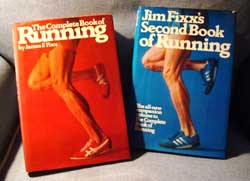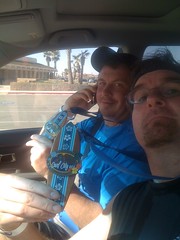 Yesterday I ran the Baltimore Marathon. It was my second Marathon, and won’t be my last as I’m already signed up to run the Surf City Marathon in my hometown of Huntington Beach, California next February. Not quite a year ago in Richmond, my friend Jay and I accomplished our goal of running a marathon and we completed a 16-week training program to reach the goal of just finishing the race. During long runs in those weeks of training, Jay and I would frequently comment that if we reached our goal of completing our first marathon, it would certainly also be our last. And yet, within hours of completing that goal (we finished in 5:56:57), Jay was saying, “We could do better”, and the thought of doing another was planted.
Yesterday I ran the Baltimore Marathon. It was my second Marathon, and won’t be my last as I’m already signed up to run the Surf City Marathon in my hometown of Huntington Beach, California next February. Not quite a year ago in Richmond, my friend Jay and I accomplished our goal of running a marathon and we completed a 16-week training program to reach the goal of just finishing the race. During long runs in those weeks of training, Jay and I would frequently comment that if we reached our goal of completing our first marathon, it would certainly also be our last. And yet, within hours of completing that goal (we finished in 5:56:57), Jay was saying, “We could do better”, and the thought of doing another was planted.
Among the things that I really enjoyed about running Richmond was that it was a great way to see a city. How often can you tour a city, with police stopping traffic so that you can run down the middle of major roads, and with cheering fans lining the course offering high-fives, snacks, and beer? It is truly a unique experience, and the thought of taking such a running tour of other cities holds great appeal to me. Some marathoners pursue the goal of running a marathon in all 50 states. I don’t know that I’ll go that far, but I’ve learned to not rule anything out either.
My Runner’s World magazine, a Christmas gift from my wife following last year’s marathon, brings a monthly dose of motivation, and advertisements for marathons across the country. And from those ads, Baltimore stood out, mostly for being relatively nearby, and in July I made the commitment and registered for the race, along with friends and family who were going to run the Half-Marathon and the 5k.
I set my goal for Baltimore at 5 hours, an hour faster than Richmond, where just finishing had been the only goal. In a previous half-marathon and a 10-miler, I had found success at reaching my goal times by creating a Pace Tag which I pinned to my shirt to keep me on track. Having goal splits handy makes every single mile a race of it’s own. Make those mile splits, and you’ll reach the goal time for the whole race. To reach my 5 hour goal time in Baltimore required a pace of 11:27 per mile. That’s a very easy pace when doing shorter training runs, but I had no idea if I could maintain it for all 26.2 marathon miles.
Happily, I found that I could. And my day-after geek came out today wanting to compare my actual performance with the goal pace I had established. The below table shows my goal pace, goal time, actual splits, pace difference, actual time, and actual difference. Where I am ahead of my goal pace, the number is in green, and where I am behind my goal pace, the number is in red.
<style>
</style>
</head>
<body link=”#0000d4″ vlink=”#993366″>
| |
|
|
|
|
|
|
| Mile |
Pace |
Goal Time |
Actual Split |
Pace Diff |
Actual Time |
Difference |
| 1 |
0:11:27 |
0:11:27 |
0:11:04 |
0:00:23 |
0:11:04 |
0:00:23 |
| 2 |
0:11:27 |
0:22:54 |
0:10:50 |
0:00:37 |
0:21:54 |
0:01:00 |
| 3 |
0:11:27 |
0:34:21 |
0:10:40 |
0:00:47 |
0:32:34 |
0:01:47 |
| 4 |
0:11:27 |
0:45:48 |
0:10:34 |
0:00:53 |
0:43:08 |
0:02:40 |
| 5 |
0:11:27 |
0:57:15 |
0:10:24 |
0:01:03 |
0:53:32 |
0:03:43 |
| 6 |
0:11:27 |
1:08:42 |
0:10:30 |
0:00:57 |
1:04:02 |
0:04:40 |
| 7 |
0:11:27 |
1:20:09 |
0:09:53 |
0:01:34 |
1:13:55 |
0:06:14 |
| 8 |
0:11:27 |
1:31:36 |
0:09:50 |
0:01:37 |
1:23:45 |
0:07:51 |
| 9 |
0:11:27 |
1:43:03 |
0:10:04 |
0:01:23 |
1:33:49 |
0:09:14 |
| 10 |
0:11:27 |
1:54:30 |
0:09:58 |
0:01:29 |
1:43:47 |
0:10:43 |
| 11 |
0:11:27 |
2:05:57 |
0:10:04 |
0:01:23 |
1:53:51 |
0:12:06 |
| 12 |
0:11:27 |
2:17:24 |
0:10:31 |
0:00:56 |
2:04:22 |
0:13:02 |
| 13 |
0:11:27 |
2:28:51 |
0:10:26 |
0:01:01 |
2:14:48 |
0:14:03 |
| 14 |
0:11:27 |
2:40:18 |
0:10:34 |
0:00:53 |
2:25:22 |
0:14:56 |
| 15 |
0:11:27 |
2:51:45 |
0:10:57 |
0:00:30 |
2:36:19 |
0:15:26 |
| 16 |
0:11:27 |
3:03:12 |
0:10:59 |
0:00:28 |
2:47:18 |
0:15:54 |
| 17 |
0:11:27 |
3:14:39 |
0:12:36 |
-0:01:09 |
2:59:54 |
0:14:45 |
| 18 |
0:11:27 |
3:26:06 |
0:11:33 |
-0:00:06 |
3:11:27 |
0:14:39 |
| 19 |
0:11:27 |
3:37:33 |
0:11:33 |
-0:00:06 |
3:23:00 |
0:14:33 |
| 20 |
0:11:27 |
3:49:00 |
0:12:13 |
-0:00:46 |
3:35:13 |
0:13:47 |
| 21 |
0:11:27 |
4:00:27 |
0:11:47 |
-0:00:20 |
3:47:00 |
0:13:27 |
| 22 |
0:11:27 |
4:11:54 |
0:11:49 |
-0:00:22 |
3:58:49 |
0:13:05 |
| 23 |
0:11:27 |
4:23:21 |
0:11:42 |
-0:00:15 |
4:10:31 |
0:12:50 |
| 24 |
0:11:27 |
4:34:48 |
0:11:57 |
-0:00:30 |
4:22:28 |
0:12:20 |
| 25 |
0:11:27 |
4:46:15 |
0:11:46 |
-0:00:19 |
4:34:14 |
0:12:01 |
| 26 |
0:11:27 |
4:57:42 |
0:11:09 |
0:00:18 |
4:45:23 |
0:12:19 |
| 26.2 |
0:02:18 |
5:00:00 |
0:05:03 |
-0:02:45 |
4:50:26 |
0:09:34 |
The race started uphill for the first 3.5 miles (see the elevation chart) As you can see I started steady and just ahead of pace and from miles 3 – 14 was enjoying the long downhill and running almost a minute ahead of my pace. By the time I had completed 16 miles, I was a almost 16 minutes ahead of my goal pace. There was a really great street party going on at mile 16, and at mile 17 I ran past the home of friends Phi and Sean, who lived up to their promise of having a mimosa waiting for me. By this point in the race I had eaten bananas, an orange, potato chips, pretzels, gold fish, vanilla power gel (gross), Skittles, and of course lots of water and Gatorade. But that mimosa went down better than any of it. Sean warned me that I was about to head into a not so great neighborhood, and suggested this knowledge may encourage me to pick up my pace (The Baltimore Sun had likewise been thoughtful enough to share information about where the marathon route intersected the worse areas of crime in the city). So I lost a minute enjoying that mimosa, and headed into the second hilly portion of the course, and as you can see, I began falling behind my goal pace, happily not by much, and not by enough to get behind the time I had banked in the first 16 miles. Miles 20 – 23 were the hardest, running around Lake Montebello, but then the course leveled and the long downhill to the finish line at the Inner Harbor began. The crowd grows, the cheers get louder, someone always seems to be offering a beer by this point, and the knowledge that the finish line is within reach provides a finishing surge. Jennifer, Colleen, and the neighborhood gals who had completed their 5k hours earlier were there at the end to see me finish, and I ended up right behind Jay who was finishing his half-marathon (he’ll join me again for his second marathon in February).
An explanation for the 5 minutes that this chart says it took me to run the final two-tenths of a mile, I promise I did not drop off that much. As I ran, I found an increasing gap between the point at which my Garmin was telling me I had hit a mile point, and the actual mile-marker for the race. First it was a tenth of a mile, eventually a quarter mile, and by the end my watch fully three tenths of a mile ahead of the actual mile markers. My only explanation is that the accumulated drifting from side to side along the race course added this extra distance. So the splits in this chart reflect my Garmin time, while the final result of 4:50:26 was my official race chip time. I forgot to stop the timer on my Garmin until I was in the chute after finishing, collecting my medal and a drink, but when I did it had my time at 4:51:20 for a distance of 26.56 miles.
Thanks Baltimore for the great running weather (overcast with some light rain, felt great), great fan support, and mostly to my family and friends who have turned running into an activity at which we motivate, participate, and celebrate together.
Like this:
Like Loading...

 Dear Apple,
Dear Apple, In November 2008, my friend Jay and I completed the Richmond Marathon. It was the first for each of us, and a successful culmination of a 16-week training program to get us across the finish line. The goal of our program was to simply complete the marathon, not in any particular time, but just to complete it. Among the many sights along the course in Richmond, was the shirt of an older gentleman that proclaimed he was ‘Larry’ of the ‘
In November 2008, my friend Jay and I completed the Richmond Marathon. It was the first for each of us, and a successful culmination of a 16-week training program to get us across the finish line. The goal of our program was to simply complete the marathon, not in any particular time, but just to complete it. Among the many sights along the course in Richmond, was the shirt of an older gentleman that proclaimed he was ‘Larry’ of the ‘





